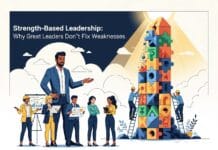How are modern HR departments and leadership teams adapting to modern tech? New technologies like AI, data analytics, and automation are transforming traditional HR and leadership practices every day. These innovations are not only streamlining processes but also enabling more strategic decision-making, personalized leadership development, and enhanced employee safety.
As companies increasingly adopt these tools, it’s clear that technology is playing a very important role in shaping the future of how we manage, develop, and support our workforce.
Automation in HR Processes
Automation has significantly reduced the time and resources spent on administrative tasks, allowing HR professionals to focus on more strategic activities. Automated systems can handle payroll, benefits administration, and compliance tracking with high accuracy, minimizing the risk of errors.
More than half of U.S. organizations have already implemented some form of HR automation, with adoption expected to rise steadily as these tools become more advanced. HR automation can also improve operational efficiency by streamlining repetitive tasks.
In addition to cost savings, automation improves the employee experience by reducing delays in HR services. For example, automated benefits enrollment or time-off requests enable employees to access necessary resources without waiting for manual approvals. This shift allows HR departments to prioritize employee development, engagement, and retention strategies.
AI-Powered Recruitment Tools
AI-powered recruitment tools are transforming the hiring process by automating candidate screening and enhancing decision-making with data-driven insights. These tools use machine learning algorithms to scan resumes, assess qualifications, and even predict candidate success based on historical data.
A recent report showed that 67% of hiring managers saw time savings by using AI in recruitment. Automating initial screenings reduces the time it takes to identify qualified candidates, allowing recruiters to focus more on interviewing and building relationships. AI tools can also reduce bias in recruitment by evaluating candidates based solely on their skills and qualifications, minimizing the influence of unconscious biases.
Employee Safety Technology
Employee safety technology is advancing rapidly, offering new ways to protect workers, especially in high-risk industries like construction and manufacturing. Wearable devices equipped with sensors monitor workers’ physical conditions, such as heart rate and body temperature, to detect signs of fatigue or heat stress.
These devices send real-time alerts to both the employee and supervisors, enabling immediate intervention before an accident occurs. Despite these safeguards injuries do sometimes happen, and consulting a personal injury lawyer can be crucial in ensuring that workers receive proper compensation and legal support for any workplace-related harm.
AI-driven safety platforms also play a significant role by analyzing work environments to identify potential hazards in real time. These systems flag safety risks based on historical data and live observations, such as areas prone to slips or falls, making workplaces safer. AI-powered cameras further enhance safety by monitoring compliance with protective equipment and safety protocols, helping organizations reduce accidents and maintain a safer work environment overall.
Data-Driven Decision Making
Data-driven decision-making in HR is transforming workforce management by providing actionable insights into employee performance, engagement, and retention. HR analytics tools can track data that reveal patterns, enabling HR teams to make more strategic decisions.
Most companies are now using data analytics in HR reporting for improved decision-making, particularly in areas like hiring, retention, and talent development. These tools allow organizations to identify trends that were previously hidden and make decisions that are rooted in quantifiable data.
Data-driven HR practices also help organizations align talent management strategies with their overall business goals. Predictive analytics, for instance, can identify employees at risk of leaving, enabling HR to implement strategies to improve retention.
Companies that have adopted data analytics for workforce planning have seen a 5-6% increase in productivity, according to research from Deloitte. This strategic use of data not only benefits employees but also drives business growth and long-term success.
AI and Machine Learning in Leadership Development
AI and machine learning are reshaping leadership development by offering personalized, data-driven coaching and training solutions. AI-driven platforms analyze leadership performance and provide tailored recommendations based on individual strengths, weaknesses, and behavioral patterns. These platforms don’t just assess current performance; they also help predict leadership potential, allowing organizations to cultivate leaders for long-term success.
Machine learning enhances leadership development by continuously refining recommendations as it gathers more data, providing real-time feedback and actionable insights. For instance, some platforms use AI to deliver personalized coaching, enabling leaders to develop skills more effectively than with traditional methods. As these technologies advance, they help leadership teams stay agile and responsive to rapidly evolving business challenges.
Blockchain in HR
Blockchain technology is becoming a critical tool in HR for enhancing data security, transparency, and efficiency. By decentralizing and encrypting sensitive employee data, such as payroll records, blockchain helps protect against data breaches.
An IBM study found that 71% of HR executives believe blockchain will transform HR, particularly in managing sensitive data. Blockchain also streamlines credential verification during hiring, reducing the time it takes to authenticate degrees, certifications, and experience.
Beyond security, blockchain enables transparency in payroll and benefits distribution. Smart contracts (self-executing agreements with terms encoded directly into the blockchain) automate payments, ensuring compliance with employment agreements. In industries with international contracts and multiple currencies, blockchain simplifies cross-border payments, reducing transaction costs.
HR Analytics and Predictive HR
HR analytics and predictive HR are revolutionizing workforce management by turning data into actionable insights. HR analytics tools analyze data on employee performance, engagement, and turnover, allowing HR teams to identify trends and make informed decisions. These insights optimize hiring strategies, predict workforce needs, and pinpoint areas for improvement in employee engagement.
Predictive HR takes analytics further by using algorithms to forecast future HR trends, such as turnover or training effectiveness. For example, predictive models can identify employees at risk of leaving, allowing organizations to take preemptive actions to improve retention.
Companies using predictive HR saw a 25% reduction in turnover rates. By leveraging predictive analytics, businesses can manage their talent proactively and align HR strategies with long-term organizational goals.
Conclusion
How can organizations afford to overlook the transformative impact of new technologies on HR and leadership? From AI-powered recruitment tools to VR-based leadership training and predictive HR analytics, these innovations are not just enhancing efficiency but reshaping how businesses develop and manage their workforce.
Embracing these technologies offers companies a competitive edge by fostering stronger leadership, improving employee safety, and making data-driven decisions that align with long-term goals. As the workplace continues to evolve, those who integrate these advancements will be best positioned to succeed in the future.





